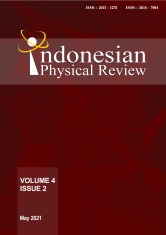POLY ORGANIC POLYMER (3-HEXYLTHIOPHENE) P3HT as LIGHT SENSITIVITY in PROTOTYPE DYE-SENSITIZED SOLAR CELLS (DSSC)
DOI:
10.29303/ipr.v4i2.84Downloads
Abstract
This research aims to review the characteristic of the nature of electricity polymer material poly(3-hexylthiophene) P3HT against increasing efficiency solar cells based on dye-sensitized solar cells (DSSC). The testing sample has done electricity P3HT el-kahfi 100/ I-V meter. The optical properties use spectrophotometer UV visible 1601 PC and characterizing IV DSSC use Keithley 2600 a type. The absorbance of P3HT polymer 1% has an absorption peak in the wavelength range of 300-650 nm. Thus the P3HT polymer material can absorb light in the visible wavelength range. The electrical properties of P3HT 1% indicate that the material has a response to light. In bright conditions, P3HT 1% shows a conductivity of 3.7x10-3Ω-1m-1 and in dark conditions 2.2x10-3Ω-1m-1. Meanwhile, Pt (Hexacloroplatinic IV) Platina as the opposing electrode can improve the performance of DSSC, which is because Pt (Hexacloroplatinic IV) functions as a catalyst to accelerate the redox reaction with electrolytes. The use of P3HT 1% can improve DSSC performance. DSSC using 1% P3HT and using Pt (Hexacloroplatinic IV) as the opposing electrode produced an efficiency value of 1.8x10-2%.
Keywords:
Dye-Sensitized Solar Cells (DSSC) Poly (3-Hexylthiophene) (P3HT) Polymer.References
M. I. Darmawan, Basransyah, and D. Rahayu Susanti. 2020. “Study Fabrication Dye Sensitized Solar Cells Using the Combined Organic Polymer Poly (3-Hexylthiophene) P3HT with Extracts Dye Natural Organic,†J. Phys. Conf. Ser., vol. 1539, No. 1, doi: 10.1088/1742-6596/1539/1/012067.
H. Hardani, H. Hendra, M. I. Darmawan, C. Cari, and A. Supriyanto. 2017 “Fabrication of dye natural as a photosensitizers in dye-sensitized solar cells (DSSC),†J. Phys. Theor. Appl., vol. 1, no. 1, pp. 21–28.
T. Priyambodo. 2007 “, Pembangkit Listrik Tenaga Surya: Memecah Kebuntuan Kebutuhan Energi Nasional dan Dampak Pencemaran Lingkungan,†no. energi terbaharukan, [Online]. Available: http://www.alpensteel.com/article/115-102-energi-matahari--surya--solar/216-pembangkit-listrik-tenaga-surya-memecah-kebuntuan-kebutuhan-energi-nasional-dan-dampak-pencemaran-lingkungan.
G. Calogero, P. Calandra, A. Sinopoli, and P. G. Gucciardi. 2010 “Metal nanoparticles and carbon-based nanostructures as advanced materials for cathode application in dye-sensitized solar cells,†Int. J. Photoenergy, vol. 20, Doi: 10.1155/2010/109495.
Callister W D Jr and Rethwisch D G. 2009. Material Science And Engineering, An Introduction 7e, 7th ed. New York.
D. Bonnet and P. Meyers. 1998. “Cadmium-telluride - Material for thin film solar cells,†J. Mater. Res., vol. 13, no. 10, pp. 2740–2753, doi: 10.1557/JMR.1998.0376.
K. Kakiage, Y. Aoyama, T. Yano, K. Oya, J. Fujisawa, and M. Hanaya, 2015. “Highly-efficient dye-sensitized solar cells with collaborative sensitization by silyl-anchor and carboxy-anchor dyes,†Chem. Commun., vol. 51, no. 88, pp. 15894–15897.
M. Thanihaichelvan, M. Kodikara, P. Ravirajan, and D. Velauthapillai. 2017.“Enhanced performance of nanoporous titanium dioxide solar cells using cadmium sulfide and poly (3-hexylthiophene) co-sensitizers,†Polymers (Basel)., vol. 9, no. 10, p. 467.
R. S. Cari , Nurussaniah, Boisandi, Anita, Agus Supriyanto. 2013. “Studi Pengaruh Konsentarasi Poly (3-Hexylthiophene)(P3HT) Terhadap Peningkatan Efisisensi Dye Sentisitized Solar Cells,†Semin. Nas. 2nd Lontar Phys. Forum.
H. Hardani, H. Hendra, M. I. Darmawan, C. Cari, and A. Supriyanto. 2016. “Pengaruh Konsentrasi Ruthenium (N719) sebagai Fotosensitizer dalam Dye-Sensitized Solar Cells (DSSC) Transparan,†J. Fis. dan Apl., vol. 12, no. 3, p. 104, doi: 10.12962/j24604682.v12i3.1340.
O. Oun et al., 2014. “Spectrochimica Acta Part A : Molecular and Biomolecular Spectroscopy Photovoltaic performance of TiO 2 electrode adsorbed with gardenia yellow purified by nonionic polymeric sorbent in dye-sensitized solar cells,†Spectrochim. Acta Part A Mol. Biomol. Spectrosc., vol. 136, pp. 1460–1466, 2015, doi: 10.1016/j.saa.10.037.
A. Gupta, V. Armel, W. Xiang, A. Bilic, and R. A. Evans, 2015.“New organic sensitizers using 4-(cyanomethyl)benzoic acid as an acceptor group for dye-sensitized solar cell applications,†Dye. Pigment., vol. 113, pp. 280–288. doi: 10.1016/j.dyepig.2014.08.023.
D. Abou-ras and T. Kirchartz, 2010. Edited by Physics of Solar Cells Thin Film Solar Cells Handbook of Photovoltaic Science and Engineering.
A. Kim, T. S. Senthil, B. S. Kwak, and M. Kang, 2015 “Improved photovoltaic ef fi ciency on TiO 2 / In 2 S 3 double layered electrodes,†vol. 150, pp. 302–308, doi: 10.1016/j.matchemphys.2014.10.021.
M. Golshan, S. Osfouri, R. Azin, and T. Jalali, 2020. “Fabrication of optimized eco-friendly dye-sensitized solar cells by extracting pigments from low-cost native wild plants,†J. Photochem. Photobiol. A Chem., vol. 388, doi: 10.1016/j.jphotochem.112191.
C. Kusumawardani and K. Indriana. 2010. Synthesis of Nanocrystalline N-Doped TiO 2 and Its Application on High Efficiency of Dye-Sensitized Solar Cells. vol. 1, no. 1, pp. 1–8.
A. Luque and S. Hegedus, 2003. Handbook of Photovoltaic Science and Engineering. Copyright Jhon Willey and sons, ltd. doi: 10.1002/0470014008.
License
Authors who publish with Indonesian Physical Review Journal, agree to the following terms:
- Authors retain copyright and grant the journal right of first publication with the work simultaneously licensed under a Creative Commons Attribution-ShareAlike 4.0 International Licence (CC BY SA-4.0). This license allows authors to use all articles, data sets, graphics, and appendices in data mining applications, search engines, web sites, blogs, and other platforms by providing an appropriate reference. The journal allows the author(s) to hold the copyright without restrictions and will retain publishing rights without restrictions.
- Authors are able to enter into separate, additional contractual arrangements for the non-exclusive distribution of the journal's published version of the work (e.g., post it to an institutional repository or publish it in a book), with an acknowledgment of its initial publication in Indonesian Physical Review Journal.
- Authors are permitted and encouraged to post their work online (e.g., in institutional repositories or on their website) prior to and during the submission process, as it can lead to productive exchanges, as well as earlier and greater citation of published work (See The Effect of Open Access).





